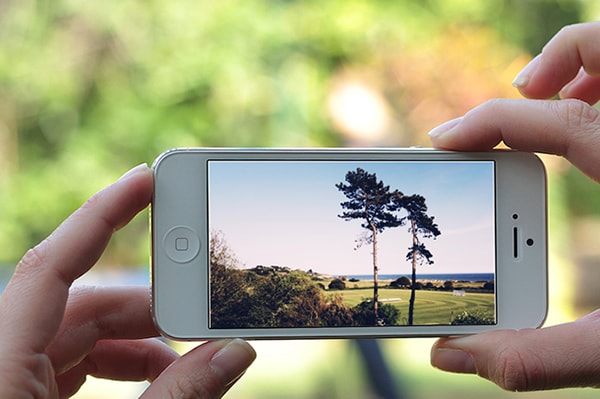The Rise Of Camera Phones And How It Affects Professional Photographers
In bygone days, when large wooden boxes, wet glass plates and an in-depth knowledge of chemistry were the tools of the photographer’s trade, photography was a difficult skill.
As cameras took roughly the form we see them in today, started using film and became more compact and affordable, photography slowly became more accessible, initially as a hobby, and then as a profession. Even then, however, becoming a professional was hard – learning by trial and error when every shot costs money is an expensive business.

photograph from PlaceIt
In the last decade or so, however, the digital age has created a boom in the number of skilled photographers out there, and as technology moves forward, the technical challenges of photography are shrinking.
As a result, the profession of photography is changing again. Now, you don’t even need to own a camera to become a pro; the phone is the number-one way of taking pictures, and the image quality achievable with today’s phones is comparable with DSLRs from only five years ago.
So what does the future hold for the professional photographer? On first inspection, it’s a dying market; the proliferation of well-equipped camera-phones seems likely to cause a significant dent in demand for photographic services. The average person is becoming increasingly confident to take their own pictures, even at important events such as weddings. In other areas of the industry, press organizations are increasingly turning to amateur contributions. Meanwhile, anyone with a phone, a filter app and a thumb can make a landscape look “pretty”.
The online population is, however, consuming more content than ever before, and people still want to see high quality images. Technology is getting better at automating the technical aspects of photography, but any camera or phone is reliant on the photographer to frame the picture. With this in mind, perhaps current professionals should consider surfing the smartphone wave, with its benefits of convenience and ease of publishing, and take heed of the old adage: if you can’t beat ’em, join ’em. And that’s just what some are doing.
Photographer Kevin Russ has traveled thousands of miles around America this year, and has funded his adventures by taking pictures and selling them as prints or stock. What makes him different is how he has taken those images – with his iPhone 5. In spite of the basic equipment, Russ’ images are of the highest quality, and as a result, he has been professionally successful enough to spend his days going where he pleases. Speaking to VSCO’s blog, Russ says his routine is to…
“…look on a map for places I want to see and then drive there and take pictures.”

photo by Kevin Russ
Could he have achieved this lifestyle taking pictures with a DSLR? Maybe. But using an iPhone has given Russ a number of advantages. With all of his images taken on auto, there is none of the hyper-focal distance, or f-number drudgery which usually comes with shooting landscapes, meaning creativity can take the front seat. Another benefit is, as Russ points out himself:
“I can shoot an image and have it processed in 30 seconds with one hand. I’d rather be out exploring than sifting through gigs of images on a computer screen.”
This increased productivity, and freedom from the computer screen, must surely be beneficial for any professional photographer.
It’s not just the creative side of photography that is changing, however. During the London 2012 Olympics, The Guardian newspaper had live coverage on their website, with updates streaming in from the reporters and DSLR-wielding photographers who were stationed around the various venues. In my opinion, however, their best coverage came from Dan Chung, whose Olympic smartphone photoblog provided a level of coverage, both in terms of text updates and in terms of photography, which was second to none. All of the content was written on or taken with his phone, and this allowed him to move swiftly from venue to venue like no ordinary hack could. Using a clip-on telephoto lens, he was able to get as close to the action as any other photographer, and his wide-angle shots of crowds and the stadium were magnificent. Were his photographs (particularly when using the clip-on lens) of stock library quality? No, but they were technically good enough to use as press images, creatively brilliant, and online almost instantly after the event – exactly what the online audience wants.
Don’t write off the pro-with-a-DSLR model, though. If you need quality, there is currently no substitute for a big camera. In addition, camera manufacturers, sensing the threat of the smartphone, are fighting back. Samsung and Nikon have both recently launched their own Android-based compacts, with Polaroid hot on their heels. With Android installed, these cameras allow all the same online functionality as a smartphone, but with a proper lens and sensor. Equally, technologies like those found in Eye-Fi memory cards have already enabled photo-journalists to send a live stream of pictures straight from their DSLRs to picture desks around the world.
In addition, there are some niche sectors of photography for which phones won’t be of any use for some time yet. The idea of shooting nature photography on a phone, for example, even with a clip-on lens, is infeasible. Phones are also not set up to fit with the essential accessories we use day-to-day – tripods, flashguns and filters, for instance – and anyone who has tried to take phone pictures in poor light knows that results are often lackluster.
It’s fair to say that phones are already making their mark on photography, and are changing the role of the professional.
But even the best camera-phones on the market are still far from ideal for many situations a professional encounters, and although companies like Apple and Nokia are working hard on developing new technologies, this state of affairs is likely to last for the foreseeable future. But just think about this – one day in the not too distant future, you might be shooting a wedding, and as the bride throws the flowers over her shoulder, a beep can be heard – the sound of your phone taking the special picture.
